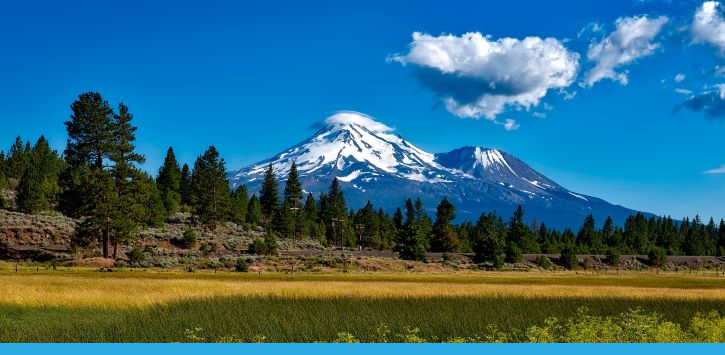In the Pacific Northwest region of the United States and Canada lie some of the most tranquilizing and stunning landscapes in all of North America. The region is riddled with sprawling forests, teeming with massive biodiversity, cradled by the Pacific ocean and marked with soaring peaks. Those soaring peaks in particular are the catalysts for much of the occurring climates and the wildlife that reside in the Pacific Northwest. Those same soaring peaks also do not go nameless, for they are called the Cascade Range.
The Cascades are a mountain range that spans from southern British Columbia in Canada, through the states of Washington and Oregon, before finally halting in northern California. Home to some of the tallest and most prominent peaks in the contiguous United States, the Cascades are renowned for their imposing mountains and gorgeous skylines. In fact, those very same mountains are accredited with affecting the climates of both the coast and the interior in one way or another.
Climate and Weather Effects
The Cascades are known for its effect on the interior and west coast of North America, particularly noticeable in stereotypical depictions of Seattle weather. What is being referred to is undoubtedly Seattle’s infamous perpetual drizzle that hangs over the city. This sullen weather can lend its cause to a few factors in the Pacific Northwest, but none are as quite apparent of a culprit as the Cascades are.
Known as a marine west coast climate — or more commonly an oceanic climate — it supplies the Pacific Northwest and much of Northern California with an abundance of precipitation in every season year round. However, these precipitations fail to gather much strength when they fall. The Cascades are an optimal illustration of oceanic climates affected by major mountain ranges, which in the Pacific Northwest’s case, constrains the climate to a narrow strip along the coastline. These mountains prevent the bulk of moisture from escaping the coast, as humid winds are impeded by steep cliffs and peaks.
Meanwhile, the eastern side of the Cascades could not be any more contrasting against the coast’s climate. As mentioned earlier, the humid winds and generally warmer air are obstructed from passing into the eastern flank of the Cascades due its high elevation and steep slopes. As a result, the interior of the states is noted for being drier and more arid than its neighboring coast. Less precipitation is not all, with more drastic temperature changes occurring, in turn causing warmer summers and colder winters due to restricted air flow into the area.
Within the Cascade Range
Between the two climates lie the Cascades themselves, in all their natural splendor. Considered to begin nearly 150 miles from the coastline in some locations, the Cascades rise dramatically over the low lying areas of the coast. From the sounds and bays of Washington to the valleys that encroach on the range’s incline, this juxtaposition of natural landscapes creates some of the most prominent peaks in the contiguous United States.
However, the peaks’ prominence alone does not define them, as there are multiple facets to the range’s identity. Marks left by both glaciers and running streams and rivers cause steep recesses between mountains which separate one peak from another. Also, due to being a relatively young mountain range (in geological timescales), the peaks are rigid and massive. Much more so than its far more smooth eastern counterparts, the Appalachian Range, who are significantly older and more weathered than the Cascade Range.
As is typical of most mountains similar to the Cascades, their origins trace to the collision of tectonic plates as one was pushed underneath the Earth’s mantle, in an event called subduction. A prominent – and dangerous – byproduct of subduction is the formation of volcanoes and magma due to shifting plates releasing the reactants to form magma. The subduction zone that forms the Cascades also stretches from Chile, up to Alaska, before climbing back down to New Zealand. It is aptly named the Ring of Fire, a name known by many.
Volcanic Danger
The Cascades Range is home to volcanoes abound, from extinct to terrifyingly alive. A prime example of the threat of active volcanoes in the region is Mount St. Helens, which dramatically showcased both residents and visitors alike of the dangers posed by the peaks. The eruption of Mount St. Helens was so powerful that it caused the northern bulge and summit to collapse, wiping out hundreds of feet of height from the mountain’s outline. Its plume and ash was carried hundreds of miles inland, almost reaching the East Coast.
The worst of all of this is that Mount St. Helens is not alone in its destructive capabilities. Although the volcano was the only one to both erupt within the last two centuries and explode on such a devastating scale, Mount St. Helens cowers in the power of other volcanoes, like Mount Rainier. As described by the United States Geological Society, “Although Mount Rainier has not produced a significant eruption in the past 500 years, it is potentially the most dangerous volcano in the Cascade Range…” Numerous factors play into this lethal mixture, but the most prominent factor for Mount Rainier’s danger is the presence of copious snow and ice on the peak. In the possibility of eruption, lahars — fast-moving rock slides that occur on volcanic mountains — could be possible, of which would be catastrophic to the surrounding area.
In a more general sense, the dangers posed by the volcanoes prove to be of continuing concern to both geologists and local residents alike. Yet despite the looming shadow of the volcanoes over the Pacific Northwest region, the area’s population continues to expand, inching ever closer into the hazard zones of the volcanoes. In the event of a major eruption, like Mount St. Helens, both daily life and economic activities would come to a screeching halt due to the effects. Not only that, but the loss of life during such a situation could be inordinate, depending on the volcano at hand, prior warnings and the type of disaster initiated by the volcano.
Though the Cascades are indeed a terrifyingly powerful force of nature when its volcanoes begin to stir, it is also home to immense beauty that comes to define nearly an entire region. This intense display of nature at its finest continues to be one of the many reasons residents and tourists alike visit the area to spend their days around the towering peaks of the Cascades. They are, truly, the epitome of the glory of nature.
Photo Credits
Image by David Marks from Pixabay.
Sources
- https://www.usgs.gov/volcanoes/mount-st-helens/1980-cataclysmic-eruption?qt-science_support_page_related_con=2#qt-science_support_page_related_con
- https://www.britannica.com/science/marine-west-coast-climate
- https://wrcc.dri.edu/Climate/narrative_wa.php
- https://www.livescience.com/43220-subduction-zone-definition.html

